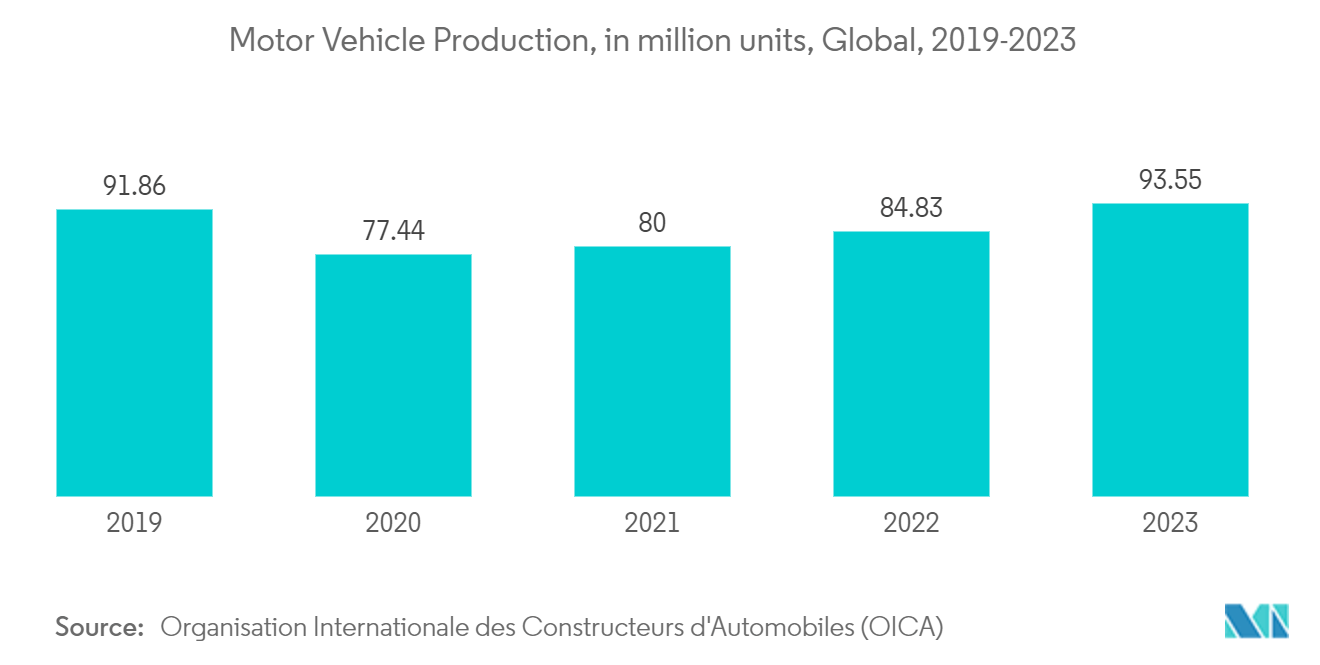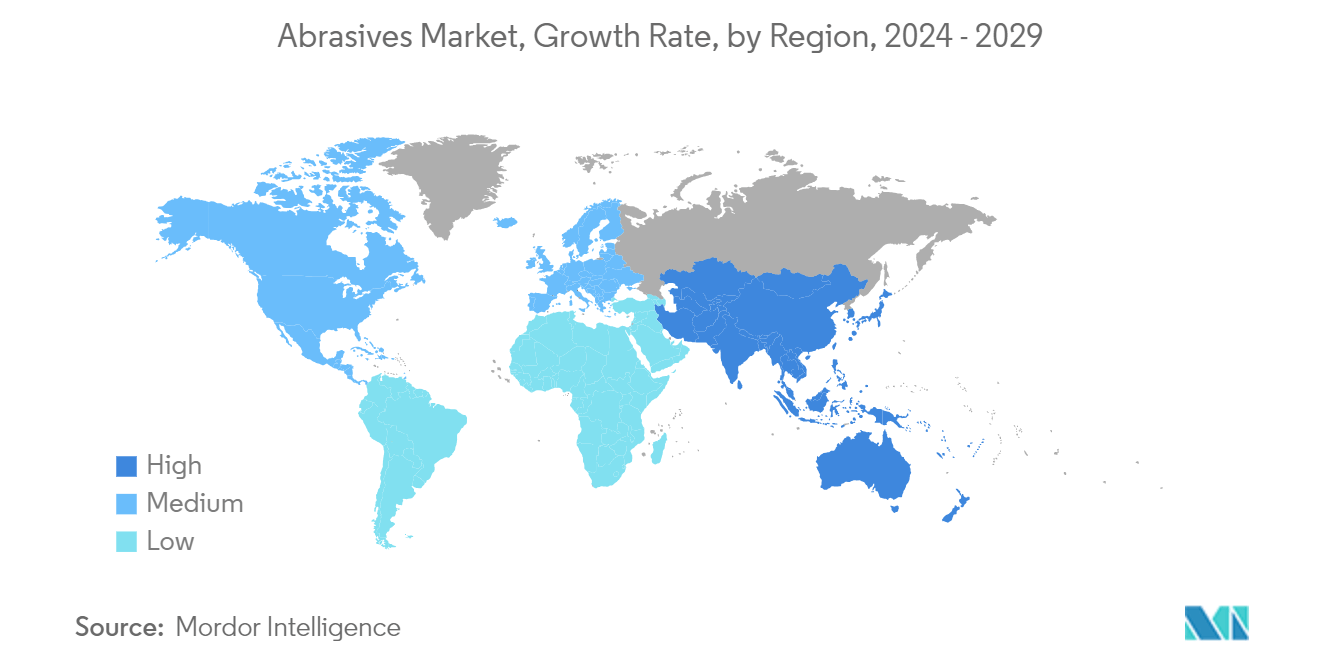Market Trends of Abrasives Industry
Increasing Use of Abrasives in the Aerospace and Automotive Industries Driving the Market
- Abrasives play a pivotal role in the automotive industry. Owing to the demand for lightweight and fuel-efficient vehicles, manufacturers are increasingly adopting bonded abrasive grinding tools in the development of high-performance automobiles.
- Abrasive grinding plays a pivotal role in the automotive industry, aiding in the production of various components, including driveline, suspension, body, and chassis parts.
- In the aerospace industry, abrasives are crucial for tasks such as cutting and polishing steam turbine castings, grinding turbine blade roots, and polishing blade airfoils.
- Bonded abrasives have extensive applications in the aerospace industry, serving purposes like rust and paint removal, deburring, fine sanding, finishing, lacquer retouching, polishing, and weld preparation.
- In 2023, the automotive industry experienced significant growth, buoyed by robust economic expansion and evolving consumer preferences. Data from the Organisation Internationale des Constructeurs d’Automobiles (OICA) revealed a production of approximately 93.55 million units of vehicles worldwide, encompassing both passenger cars and commercial vehicles. This marked a notable uptick from the roughly 84.83 million units of vehicles produced in 2022, translating to a growth rate of about 10.26%.
- Asia-Oceania emerged as the frontrunner in vehicle manufacturing, outpacing other regions. OICA data highlighted that automotive production in this region reached 55.11 million units in 2023, up by 10.18% from 2022's 50.02 million units. Notably, this production was largely spearheaded by key players like China, Japan, South Korea, and India.
- In North America, motor vehicle sales in 2023 amounted to 19.19 million units, an increase of 13.4% compared to sales in 2022, which were reported to be 16.93 million units, according to the OICA. Out of the total 19.19 million units, passenger cars comprised 3.98 million units, commercial vehicles made up 15.21 million units, and the remaining units were a combination of heavy trucks, buses, and coaches.
- Furthermore, as per data from the European Automobile Manufacturers Association, in Europe, the overall registration of new motor vehicles increased by 18.7% in 2023 compared to the previous year. In 2023, passenger car and commercial vehicle sales reached 15 million units and 2.90 million units, respectively, compared to 12.64 million units and 2.44 million units in 2022.
- Furthermore, the aerospace industry is witnessing rapid technological advancements and innovations, bolstering aircraft manufacturing. As per the Boeing Commercial Outlook 2023-2042, global demand for new commercial jets is projected to hit 48,575 by 2042, driven by a rebound in international and domestic air travel to pre-pandemic levels.
- Airbus, a leading global aircraft manufacturer, registered a notable 11% increase in its deliveries, reaching 735 commercial aircraft in 2023. Such surges are poised to fuel the demand for abrasives and, thereby, drive the market.
- As highlighted by the General Aviation Manufacturers Association, total aircraft shipments witnessed a 9.0% uptick in 2023, totaling 3,050 units. With aircraft production on the rise, the demand for abrasives is set to follow suit.
- Given these dynamics, the burgeoning automotive and aerospace industries are poised to drive demand for abrasives in the foreseeable future.

Asia-Pacific Expected to Dominate the Abrasives Market
- Asia-Pacific is expected to lead the abrasives market over the coming years, driven by surging demand from the construction, automotive, aerospace, and electronics industries.
- China's robust growth is primarily propelled by a swift expansion in its residential and commercial building industries, bolstered by a thriving economy. The nation is undergoing a sustained urbanization push, targeting a 70% urban rate by 2030. Consequently, this heightened construction activity in China is set to bolster the region's demand for abrasives.
- In South Korea, the government has ambitious plans, aiming to roll out large-scale redevelopment projects that will deliver 830,000 housing units in Seoul and neighboring cities by 2025. Of these, 323,000 new homes will grace Seoul, with Gyeonggi Province and Incheon receiving 293,000. Additionally, major urban centers like Busan, Daegu, and Daejeon are set to welcome 220,000 new residences over the next four years.
- India's burgeoning electronics manufacturing industry has emerged as a significant consumer of abrasives, with expectations of heightened demand for electronic goods in the coming years.
- According to Pankaj Mohindroo, Chairman of the Indian Cellular and Electronics Association, the total production of electronics goods in the financial year 2023-2024 was estimated to reach USD 115 billion. In addition, the Government of India allocated INR 760 million for electronic manufacturing in the country and introduced incentive schemes to boost the electronic manufacturing industry in April 2024.
- In the aerospace industry, China stands tall as the global second-largest civil aerospace market. As of January 2024, data from the National Bureau of Statistics of China and the Civil Aviation Administration revealed a fleet of 7,351 civil aircraft, marking an uptick of over 550 from 2022.
- India, as highlighted by the Indian Brand Equity Foundation (IBEF), ranks as the fourth-largest medical device market in Asia, trailing only Japan, China, and South Korea. Globally, it stands among the top 20, with projections eyeing a USD 50 billion valuation by 2025. Furthermore, India's medical device exports, valued at USD 2.90 billion in FY 2022, are on track to reach USD 10 billion by 2025.
- Given these dynamics, Asia-Pacific is set to assert its dominance in the abrasives market in the foreseeable future.


